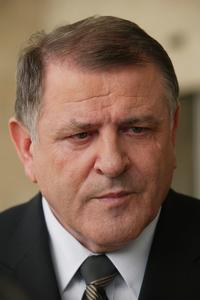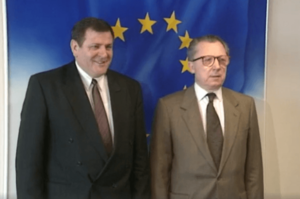Vladimír Mečiar facts for kids
Quick facts for kids
Vladimír Mečiar
|
|
|---|---|

Mečiar in 2004
|
|
| Prime Minister of Slovakia | |
| In office 13 December 1994 – 30 October 1998 |
|
| President | Michal Kováč |
| Preceded by | Jozef Moravčík |
| Succeeded by | Mikuláš Dzurinda |
| In office 24 June 1992 – 16 March 1994 |
|
| President | Michal Kováč |
| Preceded by | Ján Čarnogurský |
| Succeeded by | Jozef Moravčík |
| In office 27 June 1990 – 6 May 1991 |
|
| Preceded by | Milan Čič |
| Succeeded by | Ján Čarnogurský |
| President of Slovakia | |
| Acting 2 March 1998 – 30 October 1998 Serving with Ivan Gašparovič
|
|
| Preceded by | Michal Kováč |
| Succeeded by | Mikuláš Dzurinda (acting) Jozef Migaš (acting) |
| Acting 1 January 1993 – 2 March 1993 |
|
| Preceded by | Position established |
| Succeeded by | Michal Kováč |
| Minister of the Interior | |
| In office 11 January 1990 – 27 June 1990 |
|
| Prime Minister | Milan Čič |
| Preceded by | Milan Čič |
| Succeeded by | Anton Andráš |
| Member of the National Council | |
| In office 15 October 2002 – 12 June 2010 |
|
| In office 16 March 1994 – 13 December 1994 |
|
| Personal details | |
| Born | 26 July 1942 Zvolen, Slovakia |
| Political party | KSS (before 1970) Independent (1970–1989) VPN (1989–1991) HZDS (1991–2014) |
| Spouse | Margita Mečiarová |
| Alma mater | Comenius University in Bratislava |
Vladimír Mečiar (born 26 July 1942) is a Slovak politician who served as the prime minister of Slovakia several times. He led the country from June 1990 to May 1991, then from June 1992 to March 1994, and again from December 1994 to October 1998. He was also the leader of a political party called the Movement for a Democratic Slovakia (HZDS).
Mečiar played a key role when Czechoslovakia split into two separate countries, Slovakia and the Czech Republic, in 1992–1993. During his time as prime minister, some people criticized his leadership style.
Contents
Early Life and Education
Vladimír Mečiar was born in Detva, Slovakia, in 1942. He was the oldest of four brothers. His father worked as a tailor, and his mother was a housewife.
Starting in Politics
Mečiar began his political journey in the Communist Party of Slovakia. This was the main way to become important in Communist Czechoslovakia at the time. He became a local leader in the town of Žiar nad Hronom. However, he was removed from his position in 1969 after giving a speech that supported reforms. A year later, he was also kicked out of the Communist Party.
After leaving the party, he studied law at Comenius University in Bratislava. He worked in a glass factory while he completed his studies.
Becoming a Leader
The Velvet Revolution
In late 1989, a big change happened in Czechoslovakia called the Velvet Revolution. This was a peaceful movement that ended Communist rule. Mečiar joined a new political group called Public Against Violence (VPN) in Slovakia.
In January 1990, the VPN was looking for skilled people to join the government. Mečiar was chosen to be the Minister of the Interior and Environment for Slovakia. He was recommended by Alexander Dubček, a famous Slovak leader, who was impressed by Mečiar's knowledge.
Leading Slovakia
First Time as Prime Minister
After the first democratic elections in Czechoslovakia in June 1990, Mečiar became the Slovak prime minister. He led a government made up of his VPN party and the Christian Democratic Movement. He supported making changes to the economy and keeping Czechoslovakia as one country, but with more freedom for each part.
In 1990, many new political parties started in both the Czech Republic and Slovakia. By the end of 1990, some of Mečiar's partners in the VPN began to disagree with him. The party split into two groups in March 1991. On 23 April 1991, the Slovak parliament removed him as prime minister. Ján Čarnogurský took his place. A few days later, the VPN officially split. Mečiar then became the leader of the new party, the Movement for a Democratic Slovakia (HZDS), in June 1991.
Second Time as Prime Minister
In 1991 and 1992, leaders from the Czech Republic and Slovakia talked a lot about their future together. In June 1992, new elections were held. Vladimír Mečiar's HZDS party won in Slovakia, and Václav Klaus's party won in the Czech Republic.
Mečiar's party wanted a looser connection between the two republics, like a partnership. However, the Czech leaders wanted a more centralized country or two completely separate countries. Because they couldn't agree, Mečiar and Klaus decided on 23 July 1992, to split Czechoslovakia into two independent states. So, on 1 January 1993, Mečiar became the prime minister of independent Slovakia.
In March 1993, Mečiar's party lost some members, and he no longer had a majority in parliament. He also lost the support of the president, Michal Kováč. In March 1994, the parliament voted him out of office. A new government was formed under Jozef Moravčík.
However, after elections in late 1994, Mečiar's HZDS party won the most votes (35%). He became prime minister again, leading a government with the Slovak National Party and the Združenie robotníkov Slovenska.
Third Time as Prime Minister
During this time, Mečiar faced criticism from his opponents and other countries. People said he had an overly strong way of leading and that state media was used to promote his views. There were also concerns about how some national companies were sold off to private owners.
Relations between Mečiar and President Michal Kováč were difficult. After President Kováč's term ended in March 1998, the Slovak parliament could not agree on a new president. So, Mečiar temporarily took on the role of acting president. As acting president, he made some decisions that caused more debate.
Under Mečiar's leadership, Slovakia's progress towards joining the European Union (EU) and NATO was slower than other nearby countries. Even though Mečiar supported Slovakia joining both the EU and NATO, the country faced challenges in its relationships with Western nations.
In the 1998 elections, Mečiar's HZDS party finished first, but they couldn't form a government with other parties. So, Mikuláš Dzurinda from the opposition became the new Prime Minister. In 1999, Mečiar ran for president in the first direct election for the role, but he lost to Rudolf Schuster. In 2000, his party, HZDS, changed its name to "People's Party — Movement for a Democratic Slovakia."
After Being Prime Minister
After 2000, Mečiar seemed to step back from his main political goals. In the 2002 elections, his HZDS party still received a lot of votes (20%). However, just like in 1998, no other major party wanted to form a government with him. This meant that Mikuláš Dzurinda continued as prime minister.
The HZDS party's votes dropped in 2002 partly because of disagreements within the party before the election. Some members left and formed new parties, like the Movement for Democracy (HZD) led by Ivan Gašparovič. More members left in 2003 to create the People's Union.
In the 2004 presidential election, Mečiar tried to become president again. But he was defeated in the second round by his former ally, Ivan Gašparovič. In the 2006 parliamentary election, HZDS had its lowest election result ever, with only 8.79% of the votes. While HZDS joined a government led by Robert Fico, Mečiar himself was not a government minister. He decided not to run in the 2009 presidential election.
In the 2010 parliamentary election, Mečiar's HZDS party received only 4% of the votes. This meant they did not get any seats in the parliament for the first time. In the 2012 elections, their votes dropped even further to 0.93%, keeping them out of parliament again. Eventually, the HZDS party was officially closed down in 2014.
Personal Life
Vladimír Mečiar is married to Margita Mečiarová, who is a medical doctor. They have three children together.
See also
 In Spanish: Vladimír Mečiar para niños
In Spanish: Vladimír Mečiar para niños
- List of political parties in Slovakia
- List of presidents of Slovakia
- List of prime ministers of Slovakia


